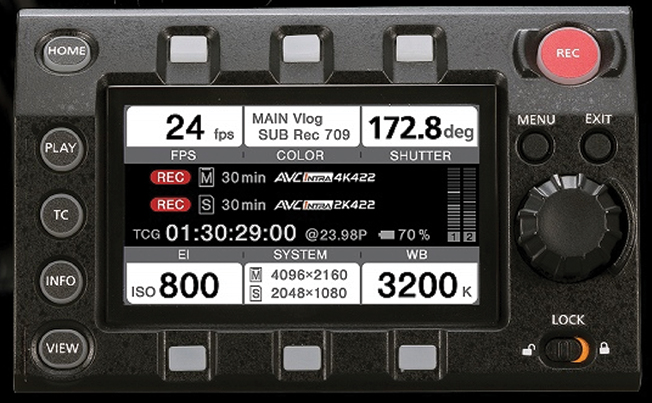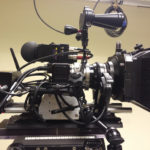
Panasonic’s Conscious De-Coupling With New VariCam
Posted on Jun 10, 2014 by Alex Fice
With the arrival of Panasonic in to the 4k camera club, the market now has another option for high end drama, movies, sport, advertising and of course wildlife, the Varicam’s natural home. We look at Panasonic’s unique ‘de-coupling’ approach to their new camera system.
Panasonic love their roadmaps. Not for them the ‘rumour-mill’ whispers ‘behind the hand’ style of product launches. Over the course of maybe 18 months they announce their road to product, they show what the product will look like and some details of what it will do and then they prepare the market by nailing a release date and price. Even in the era of neo-consumer marketing for the trade from the likes of RED, Panasonic hasn’t veered from this path and it’s a credit to them. Some observers may think this consistency of marketing a type of failing in a modern market which seems to need instant product information and re-invention, but how many times have you questioned the quality of a Panasonic product or questioned the company’s technical pioneering. The products are worth the wait.
VariCam Evolution
In the world of high definition the product name VariCam is one of the oldest. When Panasonic unveiled their unique VariCam off-speed camcorder 10 years ago the industry fell in love with its motion tricks but not it’s workflow. If you remember the original Panasonic VariCam camera, it was truly revolutionary for the time as it allowed speed ramping from one frame a second to 60 at a time when the only off-speed capture available was from film cameras. It was only 720p with a 2/3inch sensor and recorded to a tape based DVCHD codec but allowed an early look in to digital slow motion as well as being a normal 25p synch-sound product. You had to be careful using it though as many found out when they recorded off-speed footage to the same tape as their normal speed capture. You had to convert the off-speed footage through Panasonic’s own frame rate converter, one of the early pieces of advice was to record normal and off-speed footage on different tapes to avoid a long process of differentiating between frame rates.
VariCam Fans
Famous wildlife producer Alastair Fothergill had this to say about the original VariCam while he was shooting the revolutionary series Planet Earth, “There is a camera out there which gives you variable frames which is the Panasonic VariCam that happens to run at 720p. To be honest we all know in wildlife film making that slow motion is vital, I don’t just mean more than 60fps, I’m amazed that almost all of the rushes that we’re getting topside back from the field are at variable frames rates. Experienced wildlife cameramen know that at 40fps an elephant looks more beautiful than at 25. The audience won’t know because it doesn’t seem to be slowed down, but it is.”
There was a post production expense to dealing with VariCam with all the frame conversion but this didn’t kill off the interest in the camera, in fact the arrival of tapeless recording with Panasonic’s P2 technology dragged the industry in to a new era and gave VariCam a new lease of life especially with the wildlife fraternity who needed reliability and off-speed shooting as a pre-requisite. Wildlife producers were initially mistrustful of the new technology and wanted to hang on to their 16mm film cameras, but this turned out to be more about comfort than improvement.
Cameraman Martin Colbeck and director/producer Mark Linfield also shot with a later version of the VariCam on the Disney movie Chimpanzee and had these comments. “With two P2 cards it takes only 10 seconds from switching on the camera to being ready to shoot,” says Martyn. “When we got to a suitable position in which to film my assistant would set up the tripod. I’d put down my backpack, open it, switch on the camera, and by the time I had it on the tripod it was ready to go.”
Being tape-free was also a huge advantage. The AJ-HPX3700 took five 64GB P2 cards. “You have around a gigabit a minute, meaning almost six hours of recording time, not that I could get six hours a day,” jokes Martyn. “They slot into the side of the camera and you can film all day without having to change anything. You don’t need to worry about changing tapes or getting to the end, it just happens automatically.
Mark Linfield added: “Unlike tape, the rushes are file-based and already ‘digitised’ so you can instantly work on them, deleting duff clips on the computer so you’re saving on the amount of material you download. You save a fortune on tape, as well as the cost of shipping it half way across the world. It also has benefits when it comes to cloning rushes – about which our insurance company is justifiably militant.”
Of course all these benefits of tapeless workflows are well known to us now. The third-generation VariCam was shown behind a screen at last year’s NAB Convention and improved on the camera brand’s signature features, off-speed shooting and film-like images, while incorporating Panasonic’s new AVC-ULTRA family of video codecs. The camcorder had three 1920 x 1080p wide dynamic range MOS imagers for native 1080/50p recording/operation. Among the camcorder’s top-level production features were real-time high frame rate, off-speed recording to 120fps in full 1080p (in AVC-Intra Class100), a wide dynamic range and 24-bit LPCM audio. The camera also featured a range of recording formats including AVC-Intra Class100, AVC-Intra Class200 and AVC-Intra Class 4:4:4. But that particular model now remains in the box.
 The Varicam HS or High Speed.New Varicam
The Varicam HS or High Speed.New Varicam
Also at last year’s NAB was their 4K concept camera, but only as a render. People commented on its modular style without comprehending just how close they were to the finished product description. The following IBC Convention in Amsterdam put meat on the bone of the render with a physical camera unit albeit under a glass protection. Nigel Wilkes, General Manager of Panasonic in the UK takes up the story, “A lot of people had said ‘Where is Panasonic?’ talking about 4K. We were accused of being behind with 4k but it was never the case. We were monitoring the market to actually see what was needed. So when we deliver something we’re actually making something that the industry needs. There is no point coming out with just another camcorder. Over the last 12 months in the UK, we have visited three or four key accounts that have been historically VariCam users and got their advice on what they wanted from a new camcorder. They were under NDA. We asked them if we could produce something ideally for them what would they want?”
What Do You Want?
Panasonic had already written what they thought their customers wanted but wanted to know how close they were to the truth, as it turned out – very. “They said they wanted something modular, something they could use out in the field and they could get the best of both worlds from. They came up with a camcorder that would have a 4k front and a 2/3rd inch front end. What they had described is what we had on a slide for the presentation.
“What people have seen so far is something that looks like it is two cameras. The Varicam 35 which is a 4k PL mount model and then the Varicam HS 2/3rd inch model. But actually it’s one camera. We’ve built a camera that is modular. The back end which is the VTR will record up to 4k in to two card slots. There is a front end which is a single chip PL mount 35mm sensor and that will give you 14 stops of latitude and 120fps. From one to 120fps. You can then change the front end to the 2/3rd inch model so you have a 2/3rd inch mount, your possible frame rates jump up to 240fps – all on the same VTR.
“So what it means for the rental companies is they can offer a rental package for anyone. It means for those guys in the field who want that very shallow depth of field which is the single sensor 35mm image, well they’ll get that. But when they’re stuck on the side of a mountain and they want that shot right away across the hills to get an antelope of whatever, they’ve got to use very long throw lenses. Now all they have to do is take the 4k front off and stick the 2/3rd on.”
So the revolutionary idea is that instead of using another lens for the shot you’re after you change the complete front end of a camera. This is unique and designed in such a way as to be doable where you are shooting, you don’t have to go back to base or carry a completely different camera.
 VariCam 35’s remote-able side panel.
VariCam 35’s remote-able side panel.
Spec
The Varicam 35 incorporates a newly-developed super 35mm MOS image sensor and uses the company’s current AVC-ULTRA family of video codecs. Multiple formats including 4K, UHD, 2K and HD and variable frame rates up to 120 frames per second (100 fps if you’re using 50Hz) – the camera has been designed for high-end filmmaking commercials and episodic production, as well as live 4K events.
The VariCam HS 2/3 type camera head also docks with the AVC-ULTRA recording module, to provide the full functionality and ergonomics of a conventional production camera/recorder. With high speed 1080p image capture of up to 240fps, the camera is aimed at the production of high-definition imagery, for the most demanding documentaries, sports or SFX slow-motion applications.
For recording there is a next generation of P2 solid-state recording media – the expressP2 card which is 1.5x the size of the old P2 card. Specifically designed to accommodate 4K image capture, the expressP2 card offers fast transfer speeds (up to 2.4Gbps.), meaning an hour of 4K footage can be transferred within around ten minutes. One hour of RAW 4k will be 1.3TB in size.
The expressP2 card AU-XP0256A contains a flash memory error correction system, equivalent to a RAID system, to recover from a failure in a sector, page, or entire block.
Single Cable Connection
Panasonic’s Kunihiko Miyagi Director of Panasonic Professional Imaging commented on the new camera system. “The simultaneous introduction of the expressP2 card drive (AU-XPD1) will facilitate the fast offload of material from the expressP2 card at speeds of up to 2.4Gbps.
“Besides the convenience of being able to use a single recorder for the two different camera heads, the VariCam’s modular set up allows the camera and recorder to be separated, connected by a single cable. When shooting in tight quarters, on a crane, etc, room need only be made for the camera, with the recorder located somewhere with a bit more space. Please note, however, that the camera heads cannot be used without the recorder, and the recorder can only be used with the VariCam camera modules.
Nigel Wilkes, “As far as the modular approach for the camera is concerned, we knew we had to do it, it was a deal breaker. We talked about bringing out Varicam 3 which was in a glass box last year. We talked about a modular design and talked about what front end we could put on it. The thing that became apparent was if we were to bring out another shoulder camera, the kit is already out there people have already got it. What they want is true 4k, on to a card internally. You can have RAW coming out the rear if you want through 4x HDSDI. You’ve got a brand new P2 card with 256GB and of course the front end which is the most important bit. It must be 35mm size sensor with PL mount, with that option can we put a 2/3rd lens mount on? You can’t and the only way around it is to have an interchangeable front end.”
New Markets
As time goes on it will be clearer how productions will use this new arrangement of camera fronts and de-coupled recorders. You definitely see rental companies buying both front ends as together they fit in to most markets. New for Panasonic though will be the high drama and movie markets. For the first time they have a camera that ticks all those boxes. 4k, PL mount. ACES workflow, high frame rates, existing channels and reliability through the brand. A big Hollywood movie shot with a Panasonic camera can only be a matter of time.
Post NAB there will be a new showreel this time shot by Panasonic with a behind the scenes shot with Panasonic’s GH4 4k camera. This summer the camera will be very visible leading up to a shipping date in the last quarter of this year.
Never has conscious de-coupling been so exciting for lovers of cameras nevermind celebrities.
VARICAM 35 4k
• AU-V35C1 ( Camera Head ) AU-VREC1 (Recorder).
• Launch 2014 Autumn Price TBA.
• 14 stops dynamic range.
• Wide colour space.
• ACES workflow support
• 4K(4096×2160), UHD(3840×2160) / HD/ Proxy simultaneous recording with AVC-ULTRA.
• Variable Frame Rate recording with 4K up to 120p.
• Newly developed OLED EVF with Optical Zoom function.
• Uses new ExpressP2 card (AU-XP0256A) for 4K and HD@120fps recording. New drive (AU-XPD1) for ExpressP2 card.
VARICAM HS (High Speed)
• AU-V23C1 ( Camera Head ) AU-VREC1 (Recorder )
• Launch 2014 Autumn Price TBA
• High Frame Rate Recording 1-240p : base 60p/30p/24p 1-200p : base 50p/25p
(Possible to change frame rate during REC)
* OUTPUT: RGB 4:4:4, Monitor Gamma, etc
– HD/Proxy simultaneous recording.
• Uses new ExpressP2 card for high frame rate recording (HD@ more than 60fps)
• 60-240p/50p-200p, AVC-I 100
• Great image quality from newly developed 3MOS
• GAMMA: F-REC, Log, etc.







